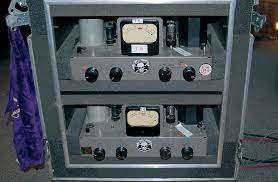As audio engineers we’re often spoilt for choice with different types of compressor, each having unique sounds and features, but the differences in their sounds and they way in which they actually compress a signal is worth taking a closer look at.
Let’s look at four main flavours of compression: Opto, FET, VCA and Vari-Mu.
Optical, or “opto” is often thought of as the smoothest type of compression due to its slow attack, which means you can get fairly aggressive without dampening the initial transient of a sound. Despite it being relatively slow, an opto compressor actually detects the incoming signal using a light element and an optical cell. To achieve compression, as an input signal increases, the light element emits more light, and in turn the optical cell attenuates the outgoing signal. We usually think of light as being the fastest thing there is, right? So it should create some almost instantaneous compression? Well, not quite.
The lack of speed in these compressors comes from the simple fact that, although light is fast, like, really fast, in an optical compressor, the components emitting and recognising light are not all that fast, so that lack of speed translates into a slow attack, thus allowing the initial transient of the audio to pass through the compressor relatively unaffected, and the rest of the signal is compressed. This kind of compressor is great on vocals where you just want to gently level out the signal, it’s often used as a leveller for bass guitar, and it imparts a degree of thickness to the sound, which can work on any range of sources.
A FET compressor is quite a different beast to the optical compressor, and operates at the opposite end of the spectrum in terms of speed. FET compressors can be extremely fast; the famous 1176 compressor could be set to an attack time of 20 microseconds! Not milliseconds, microseconds, twenty millionths of a second. This type of compressor is known for being able to destroy transients if you ask it to, but is also filled with character at slower attack times. Despite the speed of the older 1176 compressors, modern FET units can often produce far gentler compression, are excellent for real levelling out transients. FET compressors are notoriously used for snare drums, kick drums and bass guitars, but are also useful on vocals where transients are an issue.
VCA compressors, such as the famous SSL Bus compressor can be very clean sounding, but also aggressive when pushed. For aggression, think of the DBX 160VU, which produces a familiar “knock” to drums and bass guitars, but at gentler settings can be excellent for levelling out a vocal. Many bus compressors use VCA, or “Voltage Controlled Amplifiers” to level off a signal, as their gentle approach can work beautifully on a group of instruments that just need a little tying together to create a sense of cohesion.
Vari-Mu compressors are often used in mastering applications due to their valve based designs, which can add a rich warmth to a signal. Compression is achieved by driving the signal into the valves, which naturally create a gluey compression, which is often desirable in mastering. Famous Vari-Mu (or Delta-Mu compressors, to give them their original title) include the Manley Vari-Mu and the Fairchild 670, which are both known for similar, yet also quite different sounds. The Manley Vari-Mu is known for tying mixes together and being fairly unobtrusive, yet creating the cohesion needed when bringing a number of tracks together. The Fairchild, however, imparts a real sound on the signal. If you’ve ever used a software recreation, you’ll immediately hear that higher mid range frequency bump that appears just by passing audio through it. As is often the way with any in life, not just valve driven compressors, to each their own. Everyone will have a favourite for the job at hand, and that favourite may change each day.
Some compressors offer the ability to change compression topologies at the click of a button, such as the Owl Control, which allows you to change the way compression is taking place to audition different tonalities in one plugin. It’s interesting to see that, with the exception of the VCA compressors, none of the compressors named in this article feature the seemingly traditional threshold control that you would associate with a compressor. All operate by driving the signal into the compressor with an input control, and compensating for the increase or decrease in level with an output control. The Owl Control is no different, using this same method to increase compression by driving more signal into the unit. The ratio and speed controls also change when selecting different types of compression, which reflect the settings that are typically available on these types of units. The LoFi setting, for example, has far greater ratios available, which are perfect for creating aggressive compression sounds, but also smoother levelling at slow attack and release times. This compressed to the Mix Bus setting, which has far lower ratios, useful for bus processing and mastering duties, offers sounds at the complete other end of the spectrum.
Compression is not a simple subject, and far longer blogs have been written on the topic, but it’s fair to say that when compression is concerned, variety is most certainly the spice of life.


